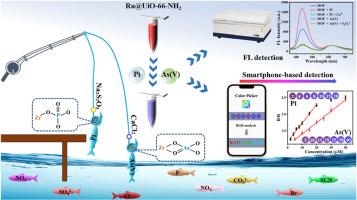Dual-emissive Ru@UiO-66-NH2 composite for selective visual detection of phosphate and arsenate
IF 6
2区 化学
Q1 CHEMISTRY, ANALYTICAL
引用次数: 0
Abstract
Background
The existence of excess phosphate (Pi) and arsenate ions [As(V)] in environment water poses significant risks to ecosystem as well as public health and often interfere each other during detection process. Although some ratiometric sensors exhibited high sensitivity towards individual Pi and As(V), few of them were applied for visual detection and portable sensing. Therefore, we need to design a convenient strategy for selective visual detection of Pi and As(V).
Results
Dual-emissive zirconium-based metal-organic frameworks (UiO-66-NH2) encapsulated tris(2,2-bipyridyl)ruthenium (II) chloride hexahydrate [Ru(bpy)32+] composite, denoted as Ru@UiO-66-NH2, has been synthesized by one-pot approach and used for ratiometric fluorescence detection of Pi and As(V). Under single excitation of 295 nm, the composite exhibited two emissions at 435 and 618 nm, originating from UiO-66-NH2 and Ru(bpy)32+, respectively. Upon the addition of Pi (or As(V)), the ligand-to-metal charge transfer (LMCT) process was weakened owing to their strong affinities with Zr–O node, inducing the enhanced blue fluorescence and unchangeable red one. In addition, they triggered clear fluorescence changes from red to pink and finally to blue. With the assistance of smartphone, visual detection of Pi and As(V) can be achieved with a limit of detection (LOD) of 0.8 μM and 1.5 μM, respectively. Furthermore, Pi and As(V) could be separately detected via the introduction of proper masking agents.
Significance
The detection method developed in this work has successfully been applied to detect Pi and As(V) in actual water samples. For the first time, Ru@UiO-66-NH2 was used for the visual detection of Pi and As(V). This work broadens the latent applications of MOF composites for on-site monitoring in environment safety assessment.


双发射Ru@UiO-66-NH2复合材料选择性视觉检测磷酸盐和砷酸盐
环境水体中过量的磷酸盐(Pi)和砷酸盐[As(V)]的存在给生态系统和公众健康带来了重大风险,并在检测过程中经常相互干扰。虽然一些比例传感器对单个Pi和As(V)具有较高的灵敏度,但很少用于视觉检测和便携式传感。因此,我们需要设计一种方便的策略来选择性地视觉检测Pi和As(V)。结果采用一锅法合成了包封三(2,2-联吡啶基)氯化钌(II) [Ru(bpy)32+]的双发射锆基金属有机骨架(UiO-66-NH2)复合材料Ru@UiO-66-NH2,并将其用于Pi和as (V)的比例荧光检测。在295 nm的单激发下,复合材料在435 nm和618 nm处有两个发射,分别来自UiO-66-NH2和Ru(bpy)32+。在加入Pi(或As(V))后,由于它们与Zr-O节点的强亲和力,使得配体到金属的电荷转移(LMCT)过程被削弱,导致蓝色荧光增强,红色荧光不变。此外,它们还引发了从红色到粉红色,最后到蓝色的清晰荧光变化。在智能手机的辅助下,可以实现Pi和As(V)的视觉检测,检测限(LOD)分别为0.8 μM和1.5 μM。此外,通过引入适当的掩蔽剂,可以分别检测到Pi和As(V)。本文所建立的检测方法已成功应用于实际水样中π和As(V)的检测。首次将Ru@UiO-66-NH2用于Pi和As(V)的视觉检测。本工作拓宽了MOF复合材料在环境安全评价现场监测中的潜在应用。
本文章由计算机程序翻译,如有差异,请以英文原文为准。
求助全文
约1分钟内获得全文
求助全文
来源期刊

Analytica Chimica Acta
化学-分析化学
CiteScore
10.40
自引率
6.50%
发文量
1081
审稿时长
38 days
期刊介绍:
Analytica Chimica Acta has an open access mirror journal Analytica Chimica Acta: X, sharing the same aims and scope, editorial team, submission system and rigorous peer review.
Analytica Chimica Acta provides a forum for the rapid publication of original research, and critical, comprehensive reviews dealing with all aspects of fundamental and applied modern analytical chemistry. The journal welcomes the submission of research papers which report studies concerning the development of new and significant analytical methodologies. In determining the suitability of submitted articles for publication, particular scrutiny will be placed on the degree of novelty and impact of the research and the extent to which it adds to the existing body of knowledge in analytical chemistry.
 求助内容:
求助内容: 应助结果提醒方式:
应助结果提醒方式:


